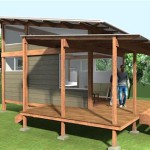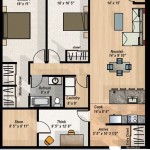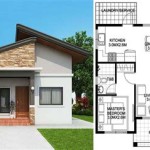Simple 1 Bedroom Apartment Floor Plans With Pictures And Dimensions
The demand for simple 1 bedroom apartment floor plans is consistently high, driven by individuals seeking affordable living spaces, students, young professionals, and those looking to downsize. These plans prioritize functionality and efficiency within a compact footprint. Understanding the common layouts, dimensions, and design considerations is crucial for prospective renters, buyers, and even interior designers aiming to maximize the potential of these spaces. This article explores various simple 1 bedroom apartment floor plans, incorporating illustrative pictures and discussing dimensions to provide a comprehensive overview.
One of the most significant benefits of a simple 1 bedroom apartment is the ease of maintenance. The smaller square footage translates directly to reduced cleaning time and lower utility bills. This appeals to individuals with busy lifestyles or those seeking to minimize their environmental impact.
Furthermore, simple 1 bedroom apartments often offer a more budget-friendly entry point to urban living. Rent or mortgage costs are typically lower compared to larger apartments or houses, allowing residents to allocate resources to other financial goals, such as savings, investments, or paying down debt.
Key Point 1: Understanding Common 1 Bedroom Apartment Layouts
Several common layouts dominate the 1 bedroom apartment market. These layouts are designed to optimize space utilization and cater to different lifestyle preferences. Familiarizing oneself with these layouts is the first step in identifying a suitable floor plan.
The Linear Layout: This layout typically features a long, rectangular shape with the living area at one end and the bedroom at the other. The kitchen and bathroom are usually situated along one side of the apartment. This design is common in older buildings and offers a straightforward, functional arrangement. Its simplicity makes furniture arrangement relatively easy, but can sometimes feel cramped if not well-designed.
The Open Concept: Open concept 1 bedroom apartments combine the living room, dining area, and kitchen into a single, expansive space. This layout maximizes natural light and creates a more social atmosphere. The bedroom is typically separated from the main living area by a wall or a partial partition. This is particularly popular with younger demographics and those who enjoy entertaining.

The Railroad Apartment: Historically, railroad apartments were long and narrow, with rooms arranged in a linear fashion, one behind the other. Access to each room was typically through the previous room, resembling a railroad car. While less common in new construction, some older buildings retain this layout. These apartments often present challenges in terms of privacy and optimal flow.
The Studio-Converted: In some cases, a studio apartment is partially converted into a 1 bedroom apartment by adding a partition to separate the sleeping area. This can provide a sense of privacy but may also compromise natural light and airflow if not executed carefully. The effectiveness of this conversion depends heavily on the size and configuration of the original studio unit.
The choice of layout depends heavily on individual needs and preferences. Open concept layouts favor sociability and spaciousness, while linear layouts prioritize compartmentalization and distinct living areas. Understanding these fundamental differences is critical when evaluating potential apartments.
Beyond the basic layout, the position of the bathroom and kitchen can significantly impact the overall functionality of the apartment. A bathroom located directly off the living area might be less desirable than one accessible from a hallway or the bedroom. The placement of the kitchen relative to natural light sources and ventilation is also a key consideration.
Key Point 2: Analyzing Dimensions and Square Footage
The overall square footage and dimensions of a 1 bedroom apartment are crucial factors that influence its livability and practicality. While size varies depending on location and building type, a general understanding of typical dimensions is beneficial.
A "simple" 1 bedroom apartment typically ranges from 500 to 750 square feet. Apartments smaller than 500 square feet may feel cramped, while those exceeding 750 square feet may be considered larger or more luxurious.
Within this range, the distribution of space is significant. A poorly designed 600 square foot apartment might feel smaller than a well-designed 550 square foot apartment. Factors such as ceiling height, window placement, and storage solutions all contribute to the perceived spaciousness. High ceilings can significantly enhance the feeling of openness, even in a smaller footprint.
Bedroom Dimensions: Ideally, a 1 bedroom apartment should have a bedroom that can comfortably accommodate a queen-size bed, two nightstands, and a dresser. A minimum bedroom size of 10 feet by 10 feet (100 square feet) is generally considered adequate. Larger bedrooms, measuring 12 feet by 12 feet or more, provide a greater sense of spaciousness and allow for additional furniture, such as a reading chair or a small desk.
Living Area Dimensions: The living area should be large enough to accommodate a sofa, coffee table, and entertainment center. A minimum living area size of 12 feet by 15 feet (180 square feet) is often sufficient. Open concept layouts may require a larger living area to accommodate both seating and dining.
Kitchen Dimensions: Kitchen size varies depending on whether it's a separate room or integrated into an open concept layout. In smaller apartments, kitchens are frequently galley-style, with appliances and countertops arranged along one or two walls. Adequate counter space and storage are essential considerations. Even in a small kitchen, efficient organization can greatly enhance functionality.
Bathroom Dimensions: Bathrooms in 1 bedroom apartments are typically compact, ranging from 5 feet by 8 feet (40 square feet) to 8 feet by 10 feet (80 square feet). Efficient use of space is critical in a small bathroom. Wall-mounted sinks, corner showers, and strategic storage solutions can maximize functionality.
When reviewing floor plans, pay close attention to the dimensions of each room and the overall layout. Consider how furniture will fit and whether the space meets your specific needs and lifestyle. Remember that square footage alone does not guarantee livability; the design and allocation of space are equally important.
Key Point 3: Visualizing Floor Plans with Pictures and Examples
Abstract floor plans can be difficult to interpret without visual aids. Pictures and examples of furnished 1 bedroom apartments provide valuable context and help to visualize how the space can be used effectively.
Example 1: The Minimalist Approach: This floor plan features a linear layout with a combined living and dining area. The furniture is kept to a minimum, with a small sofa, coffee table, and dining table with two chairs. The bedroom is sparsely furnished with a bed and a small dresser. The color palette is neutral, creating a clean and uncluttered aesthetic.

Example 2: The Maximized Storage Approach: In this floor plan, storage is prioritized. Built-in shelves and cabinets are incorporated throughout the apartment to maximize vertical space. The bedroom features a large closet and under-bed storage. The living area includes a bookcase and a storage ottoman. This approach is ideal for individuals with a large collection of belongings.
Example 3: The Open Concept Entertainment Focus: This apartment emphasizes an open concept living area designed for entertaining. A large sectional sofa provides ample seating, and a wide-screen television is mounted on the wall. The kitchen features a breakfast bar with stools for casual dining. The bedroom is tucked away at the back of the apartment for privacy.

Example 4: The Work-From-Home Adaptation: This floor plan adapts to the needs of a remote worker. A dedicated workspace is created in a corner of the living area with a desk, chair, and monitor. The bedroom is designed to promote relaxation and restful sleep. Soundproofing may be added to the workspace to minimize distractions.
Example 5: The Accessible Design Approach: This apartment prioritizes accessibility for individuals with mobility challenges. Wider doorways, grab bars in the bathroom, and lowered countertops are incorporated into the design. Clear pathways and ample space are provided for wheelchair maneuverability.
Visualizing these various approaches highlights the adaptability of simple 1 bedroom apartment floor plans. By carefully considering individual needs and preferences, residents can transform a small space into a comfortable and functional home.
Furthermore, online resources such as Pinterest, Houzz, and apartment listing websites offer a wealth of images and floor plan examples. These resources can provide inspiration and help to refine your vision for your ideal 1 bedroom apartment.
Analyzing the pictures and examples, focusing on furniture placement, color schemes, and storage solutions can assist in understanding how to optimize even the most basic 1 bedroom apartment floor plan.
In conclusion, navigating the world of simple 1 bedroom apartment floor plans requires a thorough understanding of common layouts, dimensions, and design possibilities. By carefully considering these factors and utilizing visual resources effectively, individuals can find or create a living space that meets their needs and enhances their lifestyle.

1 Bedroom Apartment Plan Examples

1 Bedroom Apartment House Plans

Free Editable Apartment Floor Plans Edrawmax

1 Bedroom Apartment Plan Examples

1 Bedroom Apartment House Plans

1 Bedroom Adu Floor Plans Designs Layouts Exteriors

1 Bedroom Apartment Plan Examples

Tiny House Floor Plan With Bedroom Loft

Simple Studio Apartment Floor Plan

1 Bedroom House Plan Room Nethouseplans
Related Posts








